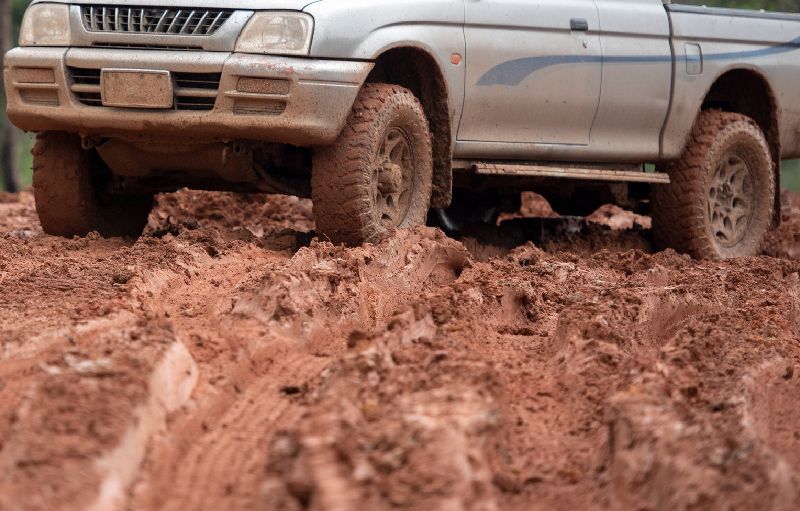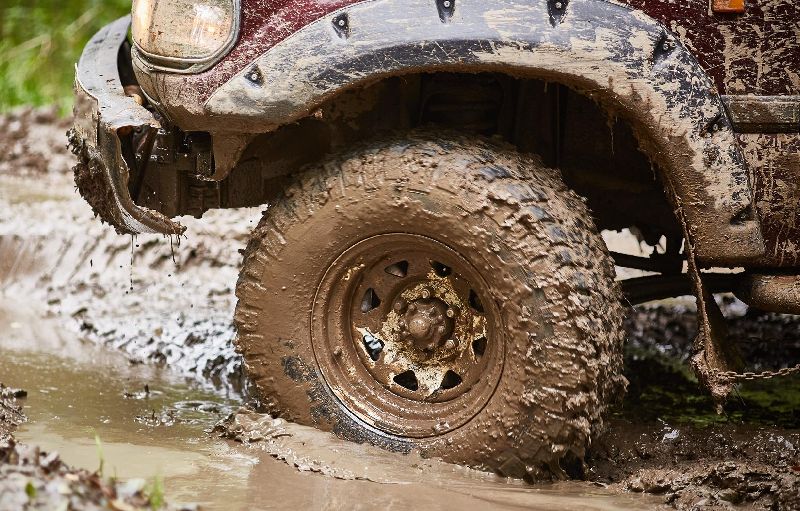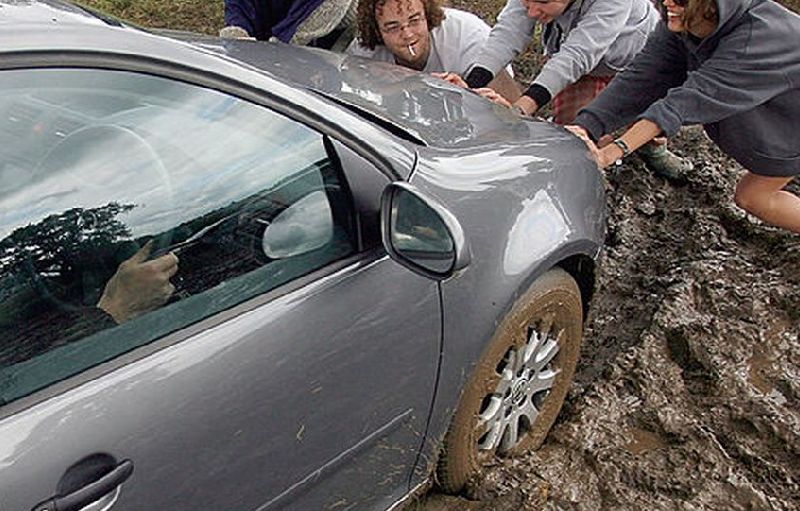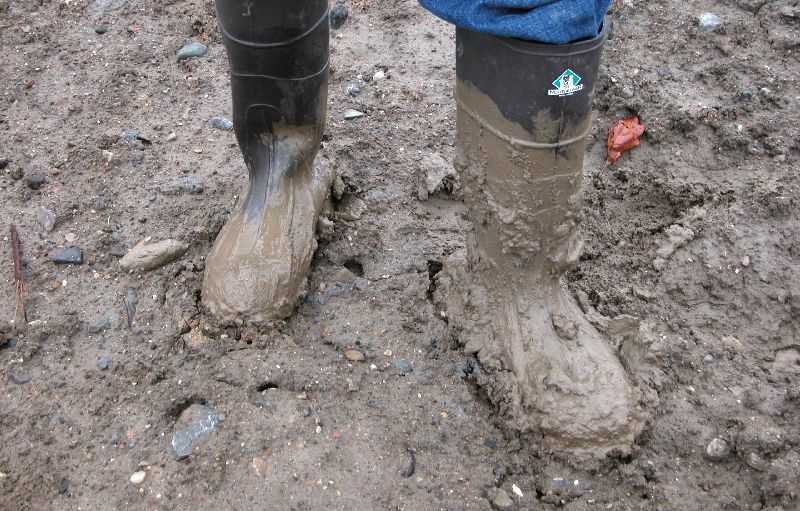We’ve all been there – the heart-sinking moment when our vehicle gets stuck in the deep, unforgiving mud. It’s a frustrating situation, but fear not! In this comprehensive guide, we’ll explore various techniques and strategies to get your vehicle unstuck without the aid of a winch. So, grab a cup of coffee, and let’s dive into the muddy adventure!
Assessing the Situation
Before jumping into action, it’s crucial to assess the situation. Take a moment to evaluate the depth and consistency of the mud. Is it a shallow mud puddle or a deep, thick sludge? Additionally, consider the condition of the surrounding area. Is there any solid ground or traction available nearby? Understanding the severity of the situation will help you choose the appropriate methods to tackle the challenge.
Preparation and Safety Measures
Safety should always be a priority when dealing with a stuck vehicle. Ensure the well-being of yourself and your passengers. Turn off the engine and engage the parking brake to prevent the vehicle from sinking further. Gather necessary tools and equipment such as a shovel, traction aids, and materials to enhance grip. Once you’re prepared, it’s time to tackle the muddy predicament.
Clearing Mud around the Vehicle
First things first, let’s get rid of excess mud around the tires and wheel wells. Use a shovel or any other available tool to carefully remove the mud. Creating a clear path in front and behind the tires will facilitate movement and prevent further entrenchment.
Improving Traction
Traction is the key to getting out of mud. Start by inflating your tires to the recommended pressure for off-roading. This increases the tire’s surface area in contact with the ground, providing better grip. Additionally, utilize traction aids such as sand mats, traction boards, or even wooden planks. Place these aids under the tires to enhance traction. If these aids aren’t available, be resourceful! Look around for branches, rocks, or other stable materials that can provide a solid foundation.
Rocking the Vehicle
Now that you’ve cleared the area and improved traction, it’s time to rock your vehicle gently. Shift between drive and reverse gears while applying light pressure to the accelerator. This rocking motion helps create momentum and loosens the grip of the mud on the tires. To enhance this technique, coordinate with a partner who can push the vehicle from behind. Remember to avoid excessive acceleration to prevent tire slippage and potential damage.
Creating Forward Momentum
Once you’ve gained some momentum from rocking, it’s time to move forward. Gradually accelerate while maintaining a slow, steady approach. The key is to maintain momentum without excessive wheel spin. Keep the steering wheel straight to avoid getting stuck in a new rut. If you encounter resistance, adjust the steering wheel gently to navigate out of the muddy area.
Seeking External Assistance
If your efforts thus far have been in vain, don’t lose hope! Reach out to nearby vehicles or passersby for assistance. Teamwork can work wonders in such situations. Coordinate efforts to attach recovery straps or ropes to another vehicle with substantial pulling power. Utilize their strength to free your stuck vehicle from the clutches of the mud.
Avoiding Future Stuck Situations
As the old saying goes, “Prevention is better than cure.” Learning from your experience is crucial to avoid future sticky situations. Practice safe off-roading techniques, familiarize yourself with your vehicle’s capabilities, and understand the terrain you’ll be traversing. Consider investing in additional equipment such as recovery tracks or a winch for future outings. These tools can provide an extra layer of preparedness and peace of mind.
Conclusion
Getting stuck in mud without a winch can be a daunting experience, but it’s not an insurmountable obstacle. By assessing the situation, preparing adequately, and utilizing the techniques discussed in this guide, you can free your vehicle and get back on track. Remember to prioritize safety at all times and seek assistance when needed. Off-roading adventures may come with their fair share of challenges, but with the right mindset and knowledge, you can conquer any muddy predicament.
So, the next time you find yourself knee-deep in mud without a winch, keep calm, take a deep breath, and apply the strategies outlined here. Your off-roading escapades will be filled with thrilling moments, and the occasional sticky situation might just become another exciting tale to share with your friends.
Safe travels, and may you navigate through mud with ease!
Additional Tips & Guides
Understanding Different Types of Mud
When it comes to getting stuck in mud, not all mud is created equal. It’s important to understand the different types of mud and their characteristics to determine the most effective approach for getting unstuck. One common type of mud is clay-based mud, which tends to be sticky and has a high suction effect on tires. Sandy mud, on the other hand, is looser and more granular, making it easier to navigate. By identifying the type of mud you’re dealing with, you can adjust your strategy accordingly to increase your chances of success.
Using Vehicle Recovery Techniques
While a winch may be the go-to tool for recovering a stuck vehicle, there are alternative techniques that can be just as effective. One such technique involves utilizing a Hi-Lift jack. By attaching the jack to a secure point on the vehicle and using it to lift the vehicle slightly, you can create enough space to clear the mud from beneath the tires. Another option is the use of tow straps or come-alongs, which can be attached to a sturdy anchor point and used to pull the vehicle out of the mud. These techniques require careful execution and proper safety measures, so it’s essential to familiarize yourself with their usage before attempting them.
Safety Considerations
When dealing with a stuck vehicle in mud, safety should always be a top priority. Before engaging in any recovery efforts, ensure that all passengers are safely out of the vehicle and in a secure location. It’s crucial to wear appropriate safety gear, including gloves and sturdy footwear, to protect yourself during the recovery process. Additionally, be mindful of potential hazards such as hidden obstacles, unstable ground, or shifting mud. Always exercise caution and proceed with care to minimize the risk of accidents or injuries.
Emergency Preparedness
Off-roading adventures can sometimes take unexpected turns, so it’s essential to be prepared for unforeseen circumstances. Carrying an emergency kit in your vehicle is a wise precaution. This kit should include items such as a first aid kit, water, non-perishable snacks, a flashlight, extra clothing, a fire extinguisher, and a communication device. Having these essentials on hand can provide reassurance and assistance in case of emergencies while waiting for help or resolving a stuck vehicle situation.
Techniques for Driving in Mud
Prevention is always better than cure, and this holds true for avoiding getting stuck in mud. When driving in muddy terrain, it’s important to employ proper techniques to minimize the risk of getting stuck. One technique is to maintain momentum by keeping a consistent speed, especially in deeper mud. Sudden braking or deceleration can cause the tires to lose traction, making it more difficult to continue forward. It’s also beneficial to avoid excessive wheel spin by using higher gears or engaging the vehicle’s differential lock if available. By applying these techniques, you can increase your chances of successfully navigating muddy terrain without getting stuck.
Recovery Equipment Alternatives
Aside from a winch, there are several recovery equipment alternatives that can assist in getting out of mud. Kinetic recovery ropes, also known as snatch straps, are designed to store and release kinetic energy, providing a powerful pulling force when used properly. Snatch blocks, which are pulley systems, can increase pulling capacity and change the direction of the force applied to the stuck vehicle. These tools can be highly effective when combined with a secondary vehicle or anchor point. Familiarize yourself with the usage and limitations of these alternatives to employ them safely and efficiently in mud recovery situations.
Common Mistakes to Avoid
When attempting to get unstuck from mud, it’s important to avoid common mistakes that can exacerbate the situation or cause additional problems. One common mistake is spinning the tires excessively. When the tires spin rapidly in place, they dig deeper into the mud, making it even harder to gain traction and get unstuck. It’s crucial to apply gradual and controlled acceleration to maintain traction without excessive wheel spin.
Another mistake to avoid is applying too much throttle. While it may be tempting to rev the engine in hopes of powering through the mud, it often leads to tire slippage and can damage the vehicle. Instead, opt for a steady and controlled approach, using the vehicle’s torque to gradually build momentum and move forward.
Using incorrect recovery techniques is another pitfall to steer clear of. Each recovery method has its own proper execution and safety considerations. It’s important to educate yourself on the specific techniques you plan to use and follow instructions meticulously. Incorrectly attaching recovery straps or ropes, for example, can lead to equipment failure or even injuries. Always double-check connections, ensure proper weight distribution, and use appropriate attachment points on the vehicle.
Neglecting to assess the surrounding area is also a mistake that can hinder progress. Before attempting any recovery technique, take a moment to evaluate the terrain and identify potential hazards or obstructions. Ensure there are no hidden objects that could damage the vehicle or impede the recovery process. It’s important to have a clear path and a safe route out of the muddy area before proceeding.
Lastly, avoid rushing the recovery process. Getting unstuck from mud can be a time-consuming task, and impatience can lead to poor decision-making. Take the necessary time to assess the situation, plan your approach, and execute the recovery techniques carefully. Rushing through the process increases the risk of making mistakes or causing further damage to the vehicle.
By being aware of these common mistakes and taking the necessary precautions, you can avoid exacerbating the situation and increase your chances of successfully getting unstuck from mud without a winch.
Environmental Considerations
While it’s important to focus on getting your vehicle unstuck, it’s equally crucial to consider the environmental impact of your actions. Off-roading enthusiasts have a responsibility to protect the natural environment and leave minimal trace behind. When recovering a stuck vehicle, be mindful of sensitive habitats, vegetation, and wildlife in the area. Avoid creating new trails or damaging the surrounding landscape. It’s advisable to stick to established trails whenever possible and practice responsible off-roading ethics.
Frequently Asked Questions
What should I do if I get stuck in mud without a winch?
Getting stuck in mud without a winch can be challenging, but there are several techniques you can try. Start by assessing the situation, clearing mud around the tires, and improving traction. You can then attempt to rock the vehicle back and forth or create forward momentum. If all else fails, seek external assistance from nearby vehicles or passersby.
How can I improve traction in muddy conditions?
To improve traction in muddy conditions, inflate your tires to the recommended pressure for off-roading. Utilize traction aids such as sand mats, traction boards, or even wooden planks under the tires. You can also use available materials like branches or rocks to create a stable foundation. These methods enhance grip and help increase traction.
Is it safe to rock the vehicle back and forth to get out of mud?
Rocking the vehicle back and forth can be an effective technique to get out of mud, but it should be done with caution. Coordinate with a partner to push the vehicle while gently shifting between drive and reverse gears. Avoid excessive acceleration to prevent tire slippage and potential damage. Safety should always be a priority during this process.
What if my attempts to get out of mud on my own fail?
If your efforts to get out of mud without a winch are unsuccessful, don’t panic. Seek assistance from nearby vehicles or passersby. Coordinate efforts to attach recovery straps or ropes to another vehicle with sufficient pulling power. Utilize their strength to free your stuck vehicle. Remember to prioritize safety and follow proper procedures when using external assistance.
How can I avoid getting stuck in mud in the first place?
To minimize the risk of getting stuck in mud, it’s important to practice safe off-roading techniques. Maintain momentum when driving through muddy areas, avoid sudden braking or deceleration, and use higher gears or differential locks for better traction. Additionally, familiarize yourself with the terrain and plan your route accordingly to avoid known muddy or waterlogged areas.
Should I invest in additional recovery equipment even if I don’t have a winch?
Investing in additional recovery equipment such as recovery tracks, kinetic ropes, or snatch blocks can be beneficial even if you don’t have a winch. These tools offer alternative methods of recovery and can assist in getting unstuck from mud. However, it’s important to familiarize yourself with their usage, limitations, and safety considerations before relying on them.
What are some safety considerations when attempting to get out of mud without a winch?
Safety should always be a top priority when trying to get out of mud without a winch. Ensure the well-being of yourself and your passengers by turning off the engine and engaging the parking brake. Use appropriate safety gear such as gloves and sturdy footwear. Assess the surrounding area for potential hazards and proceed with caution. If in doubt, seek professional assistance or advice.
How can I minimize my impact on the environment while recovering a stuck vehicle in mud?
Minimizing environmental impact is crucial when recovering a stuck vehicle in mud. Stick to established trails and avoid creating new paths or damaging vegetation. Pack out any trash or debris generated during the recovery process. Be mindful of sensitive habitats and wildlife in the area. Practicing responsible off-roading ethics ensures the preservation of the natural environment and allows future generations to enjoy the outdoors. Remember to respect and appreciate nature during the recovery process.
What should I do if I’m unable to free my vehicle from the mud?
If all your attempts to get out of the mud without a winch or external assistance fail, it’s important to remain calm. Assess the situation and consider alternative options. Depending on your location, you may need to contact a professional recovery service or towing company specialized in off-road vehicle recovery. They will have the necessary equipment and expertise to safely extract your vehicle from the mud.
Can I prevent damage to my vehicle while attempting to get out of mud?
While it’s impossible to guarantee zero damage, there are steps you can take to minimize potential harm to your vehicle. Avoid excessive wheel spin, as it can lead to tire damage. Be mindful of any obstacles or hazards in the surrounding area that could cause damage to the undercarriage or body of the vehicle. Additionally, regularly inspect your vehicle for any signs of damage or wear and address them promptly.
About The Author

Pat Rowse is a thinker. He loves delving into Twitter to find the latest scholarly debates and then analyzing them from every possible perspective. He's an introvert who really enjoys spending time alone reading about history and influential people. Pat also has a deep love of the internet and all things digital; she considers himself an amateur internet maven. When he's not buried in a book or online, he can be found hardcore analyzing anything and everything that comes his way.




